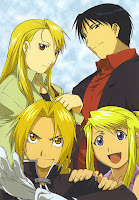Another older series, and one that I’ve been re-watching
lately, is Melody of Oblivion, and I’m reminded how confused I was by this
series when I watched it originally. I’m
also reminded how much I like the music from this series.
 Melody of Oblivion takes place in the future, a future after
a massive war has occurred between humans and “monsters” and the monsters have
won the war. Humans are living a
relatively normal existence, except for the tribute of children which is paid
to the monsters. These children are food
for the monsters, and the tribute is carefully not discussed by anyone in order
to maintain the status quo. The story
begins with one young high schooler, Bocca, realizing and objecting to the
tribute being paid, and at the same time realizing that he himself is a
“Warrior of Melos”.
Melody of Oblivion takes place in the future, a future after
a massive war has occurred between humans and “monsters” and the monsters have
won the war. Humans are living a
relatively normal existence, except for the tribute of children which is paid
to the monsters. These children are food
for the monsters, and the tribute is carefully not discussed by anyone in order
to maintain the status quo. The story
begins with one young high schooler, Bocca, realizing and objecting to the
tribute being paid, and at the same time realizing that he himself is a
“Warrior of Melos”.
Warriors of Melos are humans who can hear the “melody” of the fight against the monsters and can see a young girl who sings it. Warriors
have bonds with special semi-sentient or sentient “Aibar” machines, most of which can take human form. In addition Warriors have special abilities which allow them to kill the monsters –
something your average human cannot do. Thus
the Warriors of Melos continue to battle against the monster’s rule, despite
the fact that they are few and far between and the monsters are powerful. Bocca discovers his own abilities and
begins traveling with a girl named Sayoko who is tracking another Warrior of
Melos. Bocca originally joins her to
find this warrior to get answers to his own questions. As they go along, the answers are revealed to
him and to the people watching the series, as they run across various scenarios
and other Warriors of Melos.
 Along with fighting the monsters directly, the Warriors are
up against the Monster Union, a world-spanning group of humans that work
directly for the monsters. Each
individual member of the Monster Union runs his or her own territory as
directed by the monsters, and tries to destroy the Warriors and their Aibar
machines.
Along with fighting the monsters directly, the Warriors are
up against the Monster Union, a world-spanning group of humans that work
directly for the monsters. Each
individual member of the Monster Union runs his or her own territory as
directed by the monsters, and tries to destroy the Warriors and their Aibar
machines.
The Warriors of Melos and the Aibar machines begin to
collect and work together, trying to get to the Monster King and defeat him and
also trying to stop the Monster Union from destroying a space station that’s
purpose is to provide the energy that allows the aibar machines to function. Along the way, Bocca and Sayoko discover they
love each other, but Bocca must fight as a Warrior of Melos. He leaves her to go into space for the final
battles, not knowing if he will live to return.
Bocca and the other Warriors fight off the Monster Union long enough for the space station to be activated, ensuring its survival and the survival of the aibar machines with their abilities. At the time of the final battles, Bocca meets the Monster King, who is himself a former Warrior of Melos. The Monster King tries to get Bocca to join him, but instead Bocca kills him and returns to Sayoko. Bocca turns out to be the only Warrior who can return to earth, essentially becoming the last Warrior of Melos. Bocca and Sayoko live happily ever after, wandering and fighting the monsters and encouraging a new generation of Warriors to carry on the battle.
Bocca and the other Warriors fight off the Monster Union long enough for the space station to be activated, ensuring its survival and the survival of the aibar machines with their abilities. At the time of the final battles, Bocca meets the Monster King, who is himself a former Warrior of Melos. The Monster King tries to get Bocca to join him, but instead Bocca kills him and returns to Sayoko. Bocca turns out to be the only Warrior who can return to earth, essentially becoming the last Warrior of Melos. Bocca and Sayoko live happily ever after, wandering and fighting the monsters and encouraging a new generation of Warriors to carry on the battle.
 And if you think the plot was presented in this nice straight-forward manner, think again. It was often hard to determine what was happening, what was illusion versus 'real', and how any given scene fit into the grand scheme of things. Also the series is pretty sexually-oriented. For example, the Warriors essentially have an orgasm whenever they use their powers to super-charge their arrows, and in scenes late in the series they slather bio-gel on each other's naked bodies before going into space, etc. Often it seems the sexually-oriented scenes are irritatingly inserted just when you're waiting to find out what's going to happen, or the point of the scene is confusing, like the milking the maids scene. Still, I liked the story and music enough to buy the DVDs so I consider it worth watching.
And if you think the plot was presented in this nice straight-forward manner, think again. It was often hard to determine what was happening, what was illusion versus 'real', and how any given scene fit into the grand scheme of things. Also the series is pretty sexually-oriented. For example, the Warriors essentially have an orgasm whenever they use their powers to super-charge their arrows, and in scenes late in the series they slather bio-gel on each other's naked bodies before going into space, etc. Often it seems the sexually-oriented scenes are irritatingly inserted just when you're waiting to find out what's going to happen, or the point of the scene is confusing, like the milking the maids scene. Still, I liked the story and music enough to buy the DVDs so I consider it worth watching.








